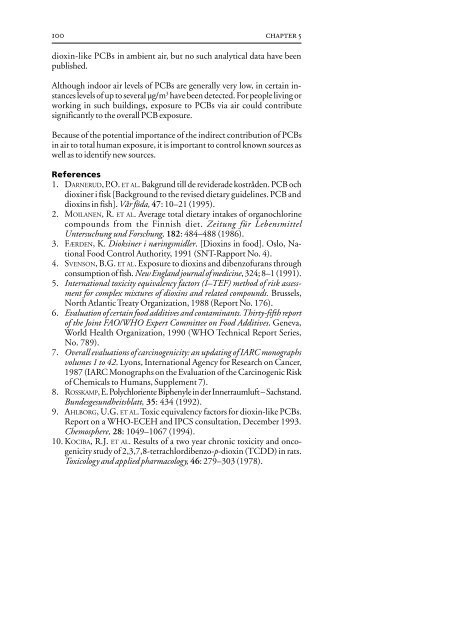Air Quality Guidelines - World Health Organization Regional Office ...
Air Quality Guidelines - World Health Organization Regional Office ...
Air Quality Guidelines - World Health Organization Regional Office ...
Create successful ePaper yourself
Turn your PDF publications into a flip-book with our unique Google optimized e-Paper software.
100 chapter 5<br />
dioxin-like PCBs in ambient air, but no such analytical data have been<br />
published.<br />
Although indoor air levels of PCBs are generally very low, in certain instances<br />
levels of up to several µg/m 3 have been detected. For people living or<br />
working in such buildings, exposure to PCBs via air could contribute<br />
significantly to the overall PCB exposure.<br />
Because of the potential importance of the indirect contribution of PCBs<br />
in air to total human exposure, it is important to control known sources as<br />
well as to identify new sources.<br />
References<br />
1. DARNERUD, P.O. ET AL. Bakgrund till de reviderade kostråden. PCB och<br />
dioxiner i fisk [Background to the revised dietary guidelines. PCB and<br />
dioxins in fish]. Vår föda, 47: 10–21 (1995).<br />
2. MOILANEN, R. ET AL. Average total dietary intakes of organochlorine<br />
compounds from the Finnish diet. Zeitung für Lebensmittel<br />
Untersuchung und Forschung, 182: 484–488 (1986).<br />
3. FÆRDEN, K. Dioksiner i næringsmidler. [Dioxins in food]. Oslo, National<br />
Food Control Authority, 1991 (SNT-Rapport No. 4).<br />
4. SVENSON, B.G. ET AL. Exposure to dioxins and dibenzofurans through<br />
consumption of fish. New England journal of medicine, 324; 8–1 (1991).<br />
5. International toxicity equivalency factors (I–TEF) method of risk assessment<br />
for complex mixtures of dioxins and related compounds. Brussels,<br />
North Atlantic Treaty <strong>Organization</strong>, 1988 (Report No. 176).<br />
6. Evaluation of certain food additives and contaminants. Thirty-fifth report<br />
of the Joint FAO/WHO Expert Committee on Food Additives. Geneva,<br />
<strong>World</strong> <strong>Health</strong> <strong>Organization</strong>, 1990 (WHO Technical Report Series,<br />
No. 789).<br />
7. Overall evaluations of carcinogenicity: an updating of IARC monographs<br />
volumes 1 to 42. Lyons, International Agency for Research on Cancer,<br />
1987 (IARC Monographs on the Evaluation of the Carcinogenic Risk<br />
of Chemicals to Humans, Supplement 7).<br />
8. ROSSKAMP, E. Polychloriente Biphenyle in der Innerraumluft – Sachstand.<br />
Bundesgesundheitsblatt, 35: 434 (1992).<br />
9. AHLBORG, U.G. ET AL. Toxic equivalency factors for dioxin-like PCBs.<br />
Report on a WHO-ECEH and IPCS consultation, December 1993.<br />
Chemosphere, 28: 1049–1067 (1994).<br />
10. KOCIBA, R.J. ET AL. Results of a two year chronic toxicity and oncogenicity<br />
study of 2,3,7,8-tetrachlordibenzo-p-dioxin (TCDD) in rats.<br />
Toxicology and applied pharmacology, 46: 279–303 (1978).

















